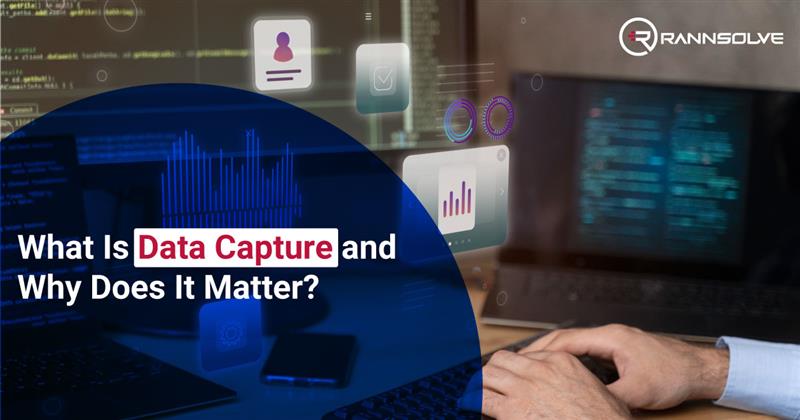Today, we’re surrounded by more information than ever. Emails, social media posts, online forms, voice commands, sensor readings—you name it, we’re generating it. For businesses, this flood of information isn’t just any random background noise; it’s a valuable resource if and only if it’s captured effectively.
This is where data capture comes in as a savior. It’s the starting point for any serious digital transformation effort, and it’s one of the most critical activities for businesses looking to improve decision-making, customer experiences, and internal processes.
So, what exactly is data capture? How does it work, and why should you care? Let’s break it down.
What Is Data Capture?
Data capture is the process of collecting and converting information—whether from physical documents or digital sources—into a format that can be stored, processed, and analyzed by an organization’s systems.
Imagine a customer fills out a form on paper. Someone needs to input that information into a system so it can be used for follow-ups, reporting, or service delivery. That’s a basic example of data capture. But it’s grown far beyond that.
Modern electronic data capture technologies and intelligent document automation make this process much easier. They help companies extract meaningful data from everything from scanned receipts to social media messages to IoT (Internet of Things) sensors—without the burden of errors.
Types of Data Capture
Not all data is created equal. The method and tools you use to capture it often depend on what kind of data you’re dealing with.
1.Structured Data
This is the neat stuff. Think names, phone numbers, or order IDs—data that fits neatly into rows and columns. It typically comes from forms, spreadsheets, or databases.
Structured data is easy to collect and analyze because it follows a predefined format. Tools like form builders and standard data entry systems handle this well.
2.Unstructured Data
Here’s where things get a bit messier. Unstructured data includes things like emails, PDFs, voice messages, social media posts, images, and videos.
Because this type of data doesn’t follow a fixed format, it requires more advanced tools to capture it. Technologies like:
- Optical Character Recognition (OCR) – to read text in images or scanned documents.
- Natural Language Processing (NLP) – to interpret and extract meaning from human language.
- Machine Learning (ML) – to identify patterns and improve data accuracy over time.
These intelligent document automation tools make it possible to transform this “messy” data into usable business insights.
3.Machine-Generated Data
This includes data coming from devices and sensors—everything from web server logs to smart thermostats to wearable fitness trackers.
Capturing this kind of data requires real-time processing and reliable infrastructure, especially since it often involves large volumes of fast-moving information.
Common Data Capture Methods
With the diversity of data types, businesses rely on various tools and methods to collect and convert it efficiently. Here are some of the most widely used:
- Optical Character Recognition (OCR): Extracts printed or typed text from images or scanned documents, helping businesses digitize paper records.
- Intelligent Character Recognition (ICR): Takes OCR further by being able to understand handwritten text—useful for customer forms or delivery receipts.
- Optical Mark Recognition (OMR): Reads checkboxes, bubbles, and marked fields—used commonly in surveys or standardized tests.
- Barcodes and QR Codes: Provide fast and easy access to information like product details, menus, URLs, or contact info using scanners or smartphones.
- Web Scraping: Automatically pulls data from websites, useful for tracking competitors, prices, or industry trends.
- Voice Capture: Used in voice assistants and call centers, this method collects spoken input and converts it into actionable data.
Each method serves a different purpose, but all aim to do the same thing: reduce manual effort and increase data accuracy.
Why Data Capture Is So Important
So, why invest in better data capture systems? What’s the payoff?
Let’s look at some of the major benefits.
1.Better Decision-Making
When businesses have access to accurate and up-to-date data, they’re better equipped to make smart, timely decisions. Whether it’s identifying trends in customer behavior or spotting inefficiencies in supply chains, clean data leads to better insights—and better outcomes.
2.Streamlined Operations
With automated data-capturing solutions, businesses can eliminate slow, manual processes. This doesn’t just save time—it also reduces human error, minimizes duplicate entries, and keeps workflows moving smoothly.
For example, in sales, capturing data from a lead’s first inquiry through to a final purchase helps teams track customer journeys and identify where things might be falling through the cracks.
3.Personalized Customer Experiences
Customers today expect businesses to “know” them, and data makes that possible. By capturing and analyzing past behaviors, preferences, and interactions, companies can tailor product recommendations, communication styles, and service experiences.
Think of it as moving from a one-size-fits-all model to a “we know what you need” experience.
4.Faster, Smarter Customer Support
When a customer calls or messages a business, support teams need context, and they need it fast. Centralized records powered by good data capture systems allow reps to see previous conversations, purchases, complaints, or feedback, all in one place.
This not only shortens response times but also improves customer satisfaction by making interactions feel more personal and informed.
Data Capture Business Outcomes
At the end of the day, data-capturing solutions are more than just scanning documents or collecting emails. It’s about building a foundation for smarter business operations.
When done right, it supports:
- Competitive analysis
- Compliance and recordkeeping
- Marketing automation
- Product development
- Revenue growth
And perhaps most importantly, it creates opportunities for companies to truly understand and connect with their audience
Rannsolve, Your Data Capture Solutions Partner
As the amount of content and information continues to grow, the ability to efficiently and accurately collect, interpret, and use that data will separate the businesses that thrive from those that struggle to keep up.
Whether you’re managing customer data, monitoring systems, or trying to understand your market, Rannsolve helps you capture the right data in the right way. Our AI-powered Data Digitization, intelligent document automation, and data extraction services, such as OCR data capture solutions and electronic data capture, offer greater accuracy and faster TAT. Speak to our data experts today!





